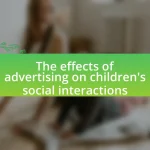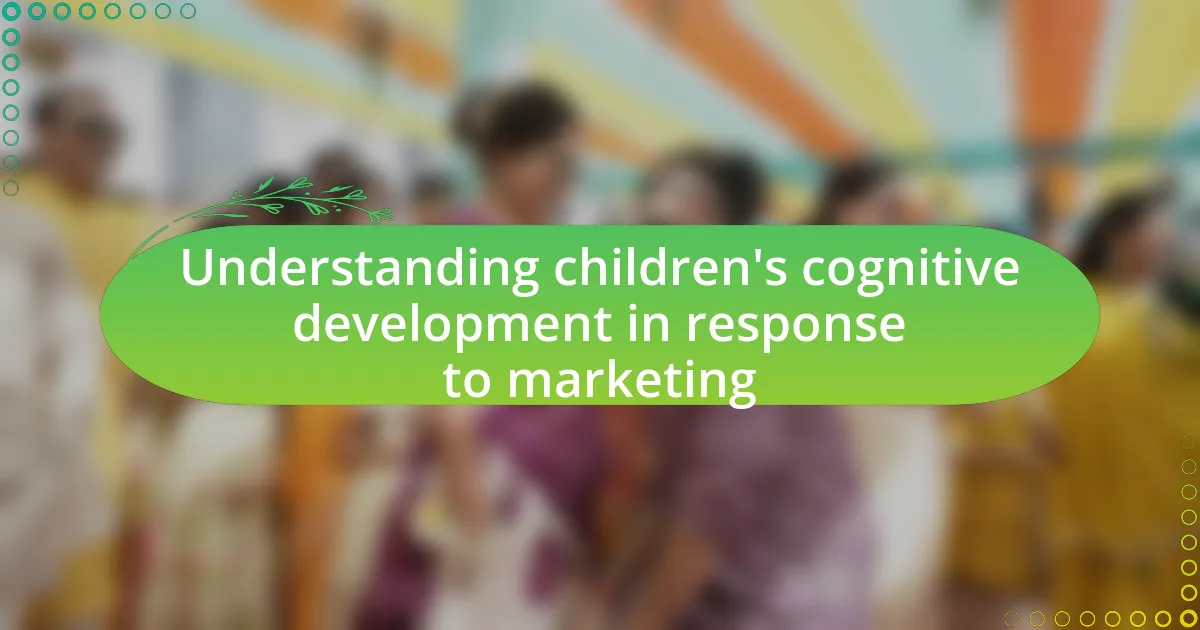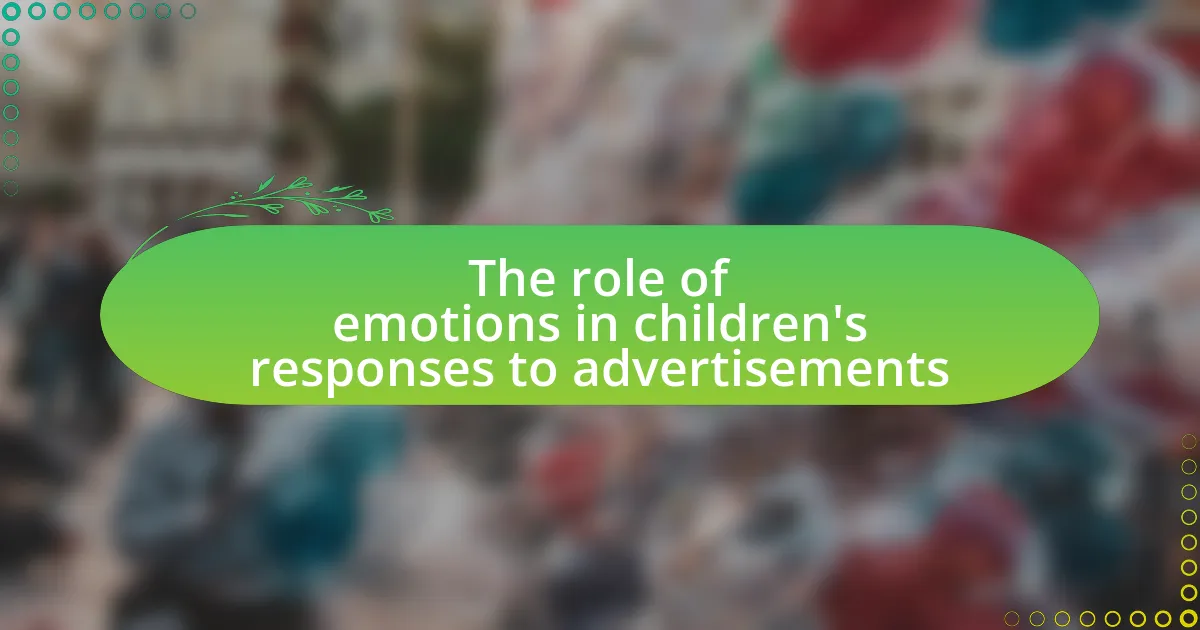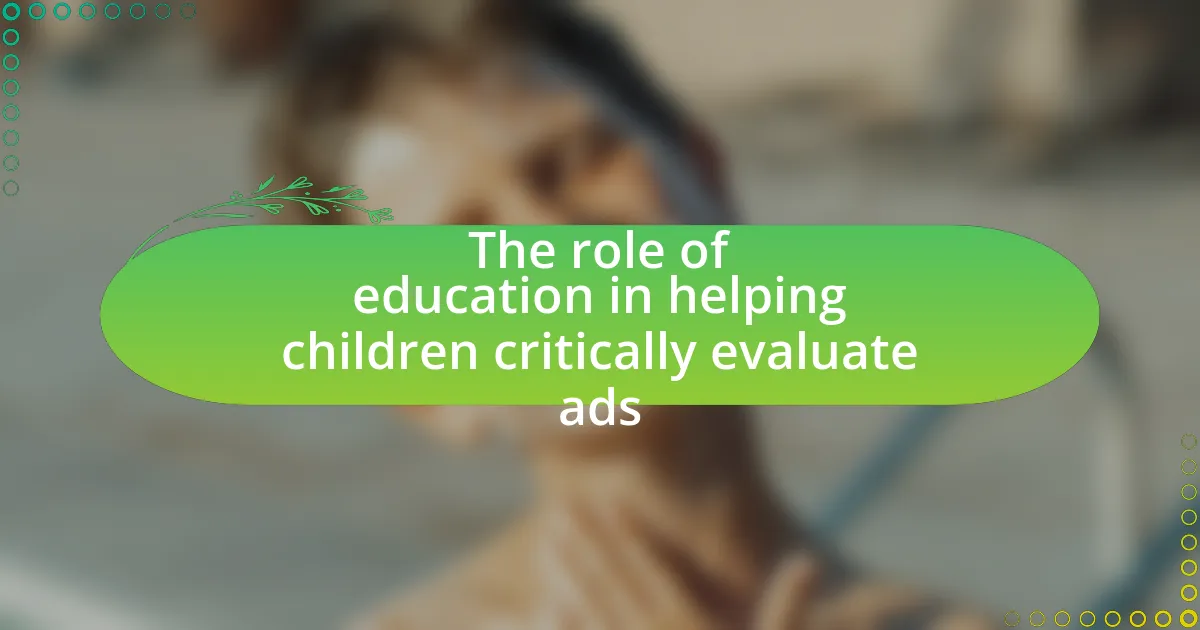The article examines the impact of advertising on children’s self-esteem, highlighting how exposure to unrealistic beauty standards and materialistic ideals can lead to body dissatisfaction and lower self-worth. It discusses the influence of advertising on children’s self-image, the specific messages that affect their perceptions, and how developmental stages shape their responses to advertising. Additionally, the article explores the long-term effects of low self-esteem, the psychological implications of advertising, and strategies for mitigating negative impacts, including media literacy education and responsible advertising practices. It emphasizes the importance of fostering critical thinking and open discussions about media to support children’s self-esteem in the face of pervasive advertising.
What is the impact of advertising on children’s self-esteem?
Advertising negatively impacts children’s self-esteem by promoting unrealistic standards of beauty and success. Research indicates that exposure to idealized images in advertisements can lead to body dissatisfaction and lower self-worth among children. A study published in the journal “Pediatrics” found that children who viewed advertisements featuring thin models reported higher levels of body dissatisfaction and lower self-esteem compared to those who did not. Additionally, advertisements often emphasize materialism, which can further contribute to feelings of inadequacy when children compare themselves to the lifestyles portrayed. This combination of factors illustrates how advertising can significantly undermine children’s self-esteem.
How does advertising influence children’s perceptions of themselves?
Advertising significantly influences children’s perceptions of themselves by shaping their self-image and self-worth through idealized representations. Children are exposed to advertisements that often portray unattainable beauty standards, material success, and social acceptance, leading them to compare themselves to these unrealistic ideals. Research indicates that exposure to such advertising can result in lower self-esteem and body dissatisfaction among children, as evidenced by a study published in the journal “Pediatrics,” which found that girls exposed to thin-ideal media reported higher levels of body dissatisfaction and lower self-esteem. This influence is particularly pronounced during formative years when children are developing their identities and self-concepts.
What specific messages in advertising affect children’s self-image?
Specific messages in advertising that affect children’s self-image include idealized portrayals of beauty, success, and lifestyle, often emphasizing unattainable standards. These messages can lead children to develop negative self-perceptions and body image issues. Research indicates that exposure to advertisements featuring thin models correlates with increased body dissatisfaction among girls, as shown in a study published in the journal “Psychology of Women Quarterly,” which found that girls exposed to such images reported lower self-esteem and higher levels of body shame. Additionally, advertisements that promote consumerism and equate happiness with material possessions can create unrealistic expectations, further impacting children’s self-worth and identity.
How do children’s developmental stages affect their response to advertising?
Children’s developmental stages significantly influence their response to advertising, as their cognitive and emotional capacities evolve over time. Younger children, typically aged 2 to 7, often lack the ability to critically evaluate advertisements, making them more susceptible to persuasive techniques such as colorful visuals and catchy jingles. Research indicates that children in this age group may not distinguish between entertainment and advertising, leading to a higher likelihood of believing claims made in ads (Linn, 2004, “Consuming Kids: The Hostile Takeover of Childhood”).
As children progress into the 7 to 12 age range, they begin to develop critical thinking skills and a better understanding of persuasive intent, which can lead to a more skeptical view of advertising. However, they are still influenced by peer pressure and social norms, making them vulnerable to ads that promote products as essential for social acceptance. Studies show that children aged 8 to 12 are more likely to respond positively to advertisements that align with their social identity (Moore & Lutz, 2000, “Children, Advertising, and Brand Loyalty”).
Adolescents, aged 13 and older, possess advanced cognitive abilities and are more capable of analyzing advertising messages. They often seek authenticity and relatability in ads, which can affect their self-esteem and brand perceptions. Research has found that adolescents are influenced by the portrayal of idealized lifestyles in advertising, which can lead to negative self-image if they feel they do not measure up (Perloff, 2014, “Social Media Effects on Young Women’s Body Image Concerns: Theoretical Perspectives and an Agenda for Research”).
In summary, children’s developmental stages shape their cognitive abilities and emotional responses, affecting how they interpret and react to advertising, which in turn impacts their self-esteem.
Why is children’s self-esteem important in the context of advertising?
Children’s self-esteem is crucial in the context of advertising because it influences their perceptions of self-worth and identity, which advertisers often exploit to drive consumer behavior. High self-esteem can lead children to feel more confident and secure, making them more receptive to advertising messages that promote products as essential for social acceptance or personal happiness. Conversely, low self-esteem can make children vulnerable to negative messaging, leading them to believe they need certain products to improve their self-image. Research indicates that advertisements targeting children frequently associate products with enhanced social status or attractiveness, which can significantly impact their self-esteem development. For instance, a study published in the Journal of Consumer Research found that children exposed to idealized images in advertising reported lower self-esteem and greater body dissatisfaction. This demonstrates the direct link between advertising content and children’s self-esteem, highlighting the importance of considering self-esteem in advertising strategies aimed at young audiences.
What are the long-term effects of low self-esteem in children?
Low self-esteem in children can lead to significant long-term effects, including increased risk of mental health issues, academic underachievement, and difficulties in social relationships. Research indicates that children with low self-esteem are more likely to experience anxiety and depression in adolescence and adulthood, as evidenced by a study published in the Journal of Youth and Adolescence, which found a strong correlation between low self-esteem in childhood and later mental health disorders. Additionally, these children often struggle with academic performance, as self-doubt can hinder their motivation and engagement in school activities. Furthermore, low self-esteem can impair social skills, leading to challenges in forming and maintaining friendships, which can perpetuate feelings of isolation and inadequacy.
How does self-esteem influence children’s behavior and choices?
Self-esteem significantly influences children’s behavior and choices by affecting their confidence in social interactions and decision-making. Children with high self-esteem are more likely to engage in positive behaviors, such as participating in group activities and making independent choices, while those with low self-esteem may exhibit withdrawal or avoidance behaviors. Research indicates that children with higher self-esteem tend to have better academic performance and are more resilient in facing challenges, as they believe in their abilities. Conversely, low self-esteem can lead to negative outcomes, including increased susceptibility to peer pressure and a higher likelihood of engaging in risky behaviors. Studies, such as those published in the Journal of Child Psychology and Psychiatry, demonstrate that self-esteem is a critical factor in shaping children’s social and academic trajectories.
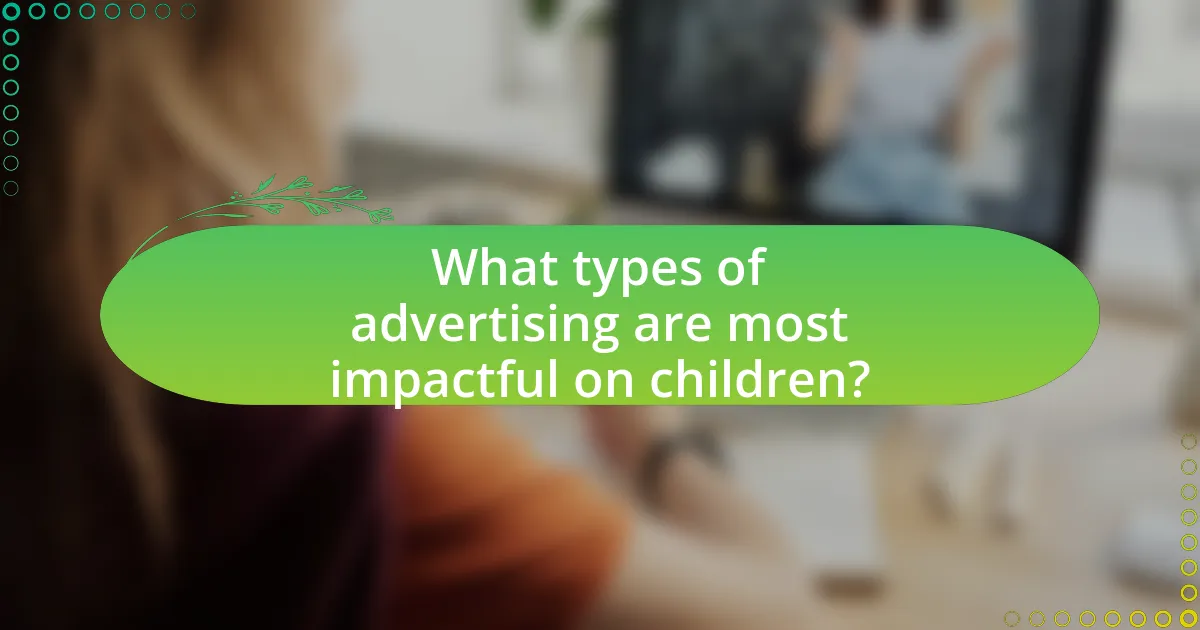
What types of advertising are most impactful on children?
The types of advertising that are most impactful on children include television commercials, online ads, and product placements in children’s programming. Television commercials are particularly effective due to their visual and auditory appeal, capturing children’s attention and influencing their preferences. Research indicates that children aged 2 to 11 are exposed to an average of 25 hours of television per week, leading to significant exposure to advertising messages. Online ads, especially those on platforms popular with children, utilize interactive elements that engage young audiences, making them more memorable. Additionally, product placements in shows and movies create a sense of familiarity and desirability, as children often associate characters they admire with the products they use. Studies have shown that these advertising methods can shape children’s self-esteem and consumer behavior, as they often equate product ownership with social acceptance and personal value.
How do different media platforms affect children’s self-esteem through advertising?
Different media platforms affect children’s self-esteem through advertising by presenting idealized images and lifestyles that children may feel pressured to emulate. Research indicates that exposure to advertisements on platforms like television, social media, and online games can lead to negative self-perception among children, as they compare themselves to the often unattainable standards depicted. For instance, a study published in the journal “Pediatrics” found that children who frequently viewed advertisements featuring thin models reported lower self-esteem and higher body dissatisfaction. This correlation highlights how the pervasive nature of advertising across various media can significantly shape children’s self-image and emotional well-being.
What role do social media and influencers play in shaping children’s self-esteem?
Social media and influencers significantly impact children’s self-esteem by shaping their perceptions of beauty, success, and social acceptance. Research indicates that children exposed to idealized images and lifestyles on platforms like Instagram and TikTok often experience increased feelings of inadequacy and lower self-worth. A study published in the journal “Cyberpsychology, Behavior, and Social Networking” found that adolescents who frequently engage with influencer content report higher levels of body dissatisfaction and lower self-esteem. This correlation suggests that the curated lives presented by influencers can create unrealistic standards that children feel pressured to meet, ultimately affecting their self-image and emotional well-being.
How does traditional advertising compare to digital advertising in its impact?
Traditional advertising generally has a broader reach but less targeted impact compared to digital advertising, which allows for precise audience segmentation and engagement. Research indicates that traditional media, such as television and print, can create strong brand awareness among children, yet digital platforms enable interactive experiences that can significantly influence children’s self-esteem through personalized content. A study by the American Psychological Association found that children exposed to digital advertising are more likely to develop materialistic values, which can negatively affect their self-esteem, while traditional advertising often promotes aspirational lifestyles without direct interaction. Thus, while both forms of advertising impact children’s self-esteem, digital advertising tends to have a more immediate and personalized effect.
What are the psychological effects of advertising on children?
Advertising significantly influences children’s psychological development, often leading to issues such as low self-esteem, materialism, and unhealthy body image perceptions. Research indicates that children exposed to advertising are more likely to develop a desire for products that promise social acceptance or popularity, which can create feelings of inadequacy when they cannot attain these ideals. A study published in the Journal of Consumer Research found that children who viewed advertisements featuring idealized images were more likely to report dissatisfaction with their own appearance and increased pressure to conform to societal standards. This correlation highlights how advertising can shape children’s self-worth and perceptions of success, ultimately impacting their mental health and social interactions.
How does exposure to idealized images in advertising affect children’s body image?
Exposure to idealized images in advertising negatively affects children’s body image by promoting unrealistic standards of beauty. Research indicates that children who frequently view such images are more likely to develop body dissatisfaction and low self-esteem. A study published in the journal “Body Image” found that girls exposed to idealized media images reported higher levels of body dissatisfaction and a greater desire to lose weight. Additionally, boys exposed to similar content showed increased concerns about muscularity and body image. These findings highlight the significant impact that idealized representations in advertising can have on children’s perceptions of their own bodies.
What is the relationship between advertising and children’s mental health?
Advertising negatively impacts children’s mental health by promoting unrealistic standards and materialism, which can lead to issues such as low self-esteem and body image concerns. Research indicates that exposure to idealized images in advertisements correlates with increased dissatisfaction among children regarding their appearance and social status. A study published in the Journal of Adolescent Health found that children who frequently view advertisements are more likely to experience anxiety and depression related to their self-image. This relationship underscores the significant influence advertising has on shaping children’s perceptions of themselves and their worth.
What strategies can mitigate the negative impact of advertising on children’s self-esteem?
To mitigate the negative impact of advertising on children’s self-esteem, parents and educators can implement media literacy programs that teach children to critically analyze advertisements. Research indicates that children who participate in media literacy education are better equipped to understand the persuasive intent of advertising, which can reduce feelings of inadequacy and low self-worth associated with unrealistic portrayals of beauty and success. For example, a study published in the Journal of Advertising Research found that media literacy interventions led to a significant decrease in the internalization of thin ideals among young girls, thereby improving their self-esteem. Additionally, promoting positive body image and self-acceptance through supportive family environments can further counteract the adverse effects of advertising.
How can parents and educators help children critically analyze advertisements?
Parents and educators can help children critically analyze advertisements by teaching them to identify persuasive techniques and evaluate the messages being conveyed. This can be achieved through discussions about the intent behind advertisements, such as understanding how emotions, imagery, and language are used to influence consumer behavior. Research indicates that children who engage in media literacy programs show improved critical thinking skills regarding advertisements, which can mitigate negative impacts on self-esteem. For example, a study published in the Journal of Advertising Research found that children exposed to media literacy education were better equipped to recognize manipulative advertising tactics, leading to healthier self-perceptions.
What resources are available for teaching media literacy to children?
Resources available for teaching media literacy to children include educational programs, online platforms, and curriculum guides. For instance, the Center for Media Literacy offers a comprehensive framework and resources that help educators teach critical thinking about media. Additionally, Common Sense Media provides lesson plans and activities designed to enhance children’s understanding of media messages and their effects. The Media Literacy Now organization advocates for media literacy education and provides resources for educators to implement in classrooms. These resources are validated by research indicating that media literacy education can significantly improve children’s ability to analyze and evaluate media content, thereby positively influencing their self-esteem and critical thinking skills.
How can open discussions about advertising improve children’s self-esteem?
Open discussions about advertising can improve children’s self-esteem by fostering critical thinking and media literacy. When children engage in conversations about the messages and images presented in advertisements, they learn to analyze and question the unrealistic standards often portrayed. Research indicates that children who are taught to critically evaluate media content are less likely to internalize negative body images and low self-worth. For instance, a study published in the Journal of Adolescent Health found that media literacy programs significantly reduced body dissatisfaction among adolescents. By equipping children with the tools to understand and critique advertising, they can develop a healthier self-image and greater confidence in their own identities.
What are some best practices for responsible advertising aimed at children?
Responsible advertising aimed at children should prioritize transparency, age-appropriate content, and educational value. Advertisers must ensure that messages are clear and not misleading, as children may struggle to differentiate between entertainment and advertising. Content should be designed to be suitable for the target age group, avoiding themes that could negatively impact self-esteem, such as unrealistic body images or materialism. Additionally, incorporating educational elements can foster positive development, as seen in campaigns that promote healthy habits or social values. Research indicates that responsible advertising can enhance children’s understanding of media and improve their critical thinking skills, ultimately supporting their self-esteem.
How can advertisers create content that promotes positive self-esteem in children?
Advertisers can create content that promotes positive self-esteem in children by focusing on inclusive messaging that celebrates diversity and individuality. Research indicates that advertisements featuring children of various backgrounds and abilities can enhance self-acceptance and reduce feelings of inadequacy. For example, a study published in the Journal of Advertising Research found that campaigns showcasing diverse representations lead to higher self-esteem among viewers, as they see themselves reflected in the media. Additionally, using positive affirmations and messages that encourage self-worth, rather than comparisons to idealized standards, can foster a healthier self-image in children.
What regulations exist to protect children from harmful advertising practices?
Regulations that protect children from harmful advertising practices include the Children’s Online Privacy Protection Act (COPPA) in the United States, which restricts the collection of personal information from children under 13 without parental consent. Additionally, the Federal Trade Commission (FTC) enforces guidelines that prohibit deceptive advertising targeted at children, ensuring that advertisements are not misleading. In the European Union, the Audiovisual Media Services Directive (AVMSD) sets strict rules on advertising to children, including limitations on the types of products that can be advertised and the timing of such advertisements during children’s programming. These regulations aim to safeguard children’s well-being and prevent exploitation through advertising practices that could negatively impact their self-esteem.
What practical tips can parents use to support their children’s self-esteem in the face of advertising?
Parents can support their children’s self-esteem in the face of advertising by fostering open communication about media messages. Engaging children in discussions about the unrealistic portrayals in advertisements helps them critically analyze what they see. Additionally, parents should encourage their children to focus on their unique strengths and qualities, reinforcing a positive self-image that is not reliant on external validation. Research indicates that children who receive positive reinforcement from parents are more resilient to negative media influences, as highlighted in a study published in the Journal of Adolescent Research, which found that parental support significantly mitigates the impact of media on self-esteem. By modeling healthy self-esteem and media literacy, parents can effectively counteract the negative effects of advertising.

